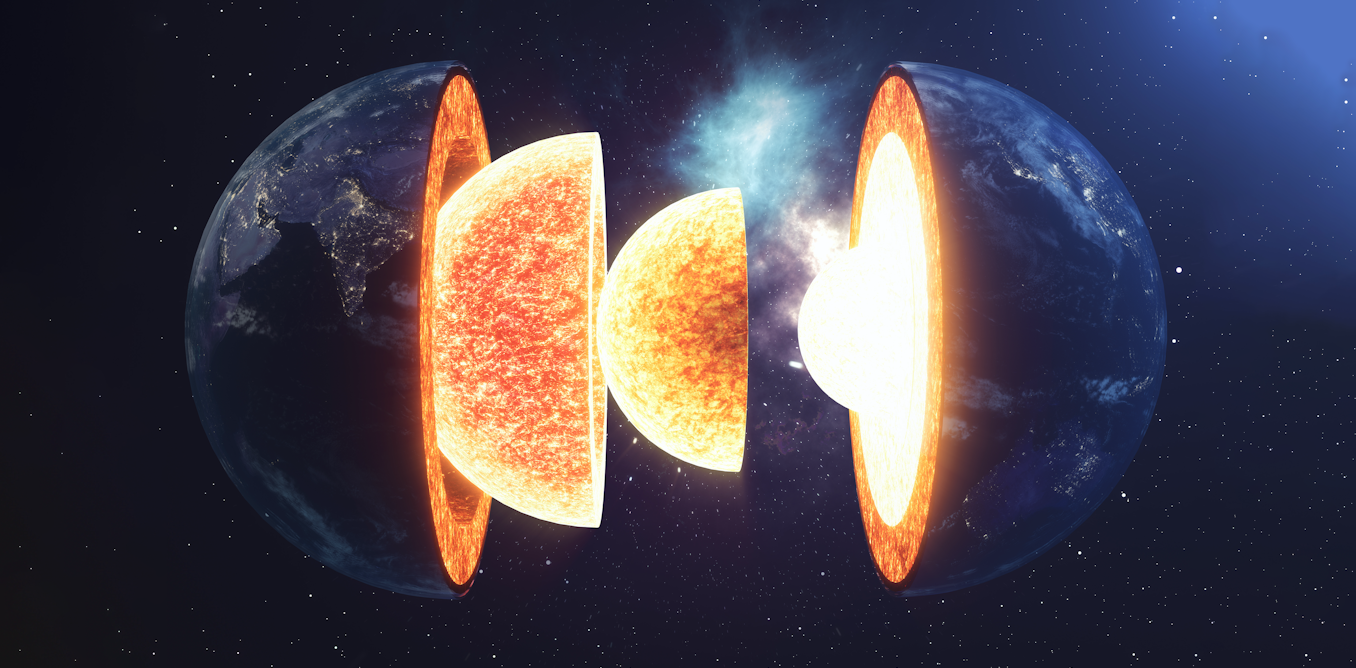Earthquakes. Seismology, Core Detection
"We analyzed digital records of ground motion, known as seismograms from large earthquakes in the last decade.""The latent heat released from solidifying the Earth's inner core drives the convection in the liquid outer core, generating Earth's geomagnetic field.""Life on Earth is protected from harmful cosmic rays and wo9uld not be possible without such a magnetic field."ThanhSon Pham, observational seismologist, Australian National University, Canberra"I like to think about the inner core [of Earth] as a planet within the planet. Indeed, it is a solid ball, approximately the size of Pluto and a bit smaller than the moon.""If we were somehow able to dismantle the Earth by removing its mantle and the liquid outer core, the inner core would appear shining like a star.""Its temperature is estimated to be about, 5,500 to 6,000 degrees Celsius, similar to the sun's surface temperature."Hrvoje Tkalcic, geophysicist, Australian National University
 |
Seismic waves have helped researchers to learn about the layers that comprise Earth’s solid centre. Credit: Maksym Yemelyanov/Alamy |
An intensive study of Earth's deep interior was published on Tuesday in the journal Nature Communications. Researchers from the Australia National University based their study on the behaviour of seismic waves resulting from large earthquakes, confirming the presence of a distinct structure within Earth's inner core. Where an immensely heated innermost solid ball of iron and nickel exists, roughly 1,350 kilometres in width.
Earth's internal structure itself about 12,750 km, is comprised of four layers; a rocky crust on the exterior, a rocky mantle within, an outer core of magma and a solid inner core. The metallic inner core is about 2,440 km in width, discovered in the 1930s -- a discovery also based on seismic waves travelling through Earth.
Then in 2002m\, scientists proposed that within the inner core was an innermost section separated from all else, similar to a Ukrainian nesting doll. This discovery was enabled by the increasing sophistication of seismic monitoring. Seismic waves are unleashed by earthquakes, travelling through the planet; monitoring the waves can reveal interior contour structure based on the changing shape of the waves.
Up to the present, scientists detected these waves bouncing up from one side of Earth to the other and then back again. Waves from 200 quakes were studied in this newly published research, where quakes with magnitudes above 5.0 ricocheted up to five times within the planet. Enabling the discovery of the inner core's outer shell and confirmed innermost sphere, both sufficiently heated to become molten, but a solid iron-nickel alloy resulting from the immense pressure at the centre of the Earth rendering them to a solid state.
Researchers were able to differentiate the inner and innermost spheres and their solid core with the seismic waves acting differently between each. Slowly growing in size, the inner core is narrowing the outer core by solidifying molten materials as Earth continues its gradual cooling process, a continuation that began at its formation about 4.5 billion years ago.
"[The study is important because it offers a measurement of Earth’s innermost section that was very difficult to achieve.] It requires finding seismic waves recorded at very long distance and that are fairly weak in amplitude, and then enhancing the amplitude so that you could measure the wave speed in the very deep interior of the Earth."Geophysicist Vernon Cormier, University of Connecticut
 e e |
In a new study, we’ve observed clues that distinguish the very deepest part of Earth’s core |
Labels: Australia, Core Solid Mass, Earth's Inner Inner Core, Earth's Mantle, Research

0 Comments:
Post a Comment
<< Home